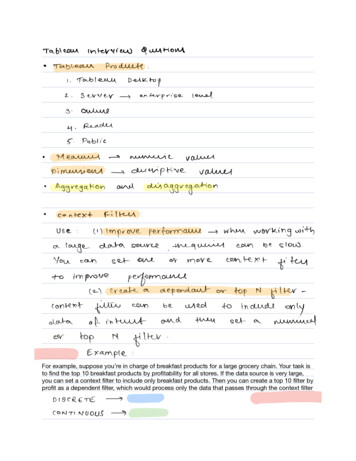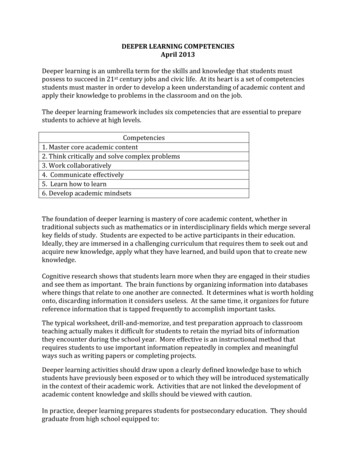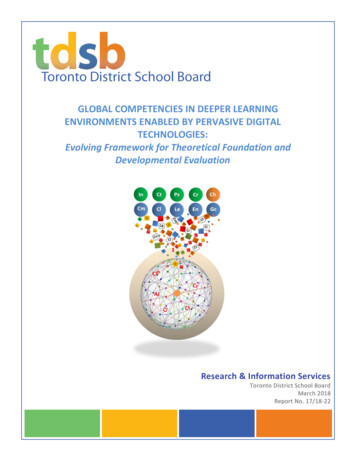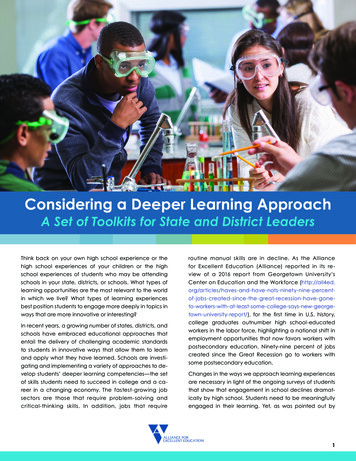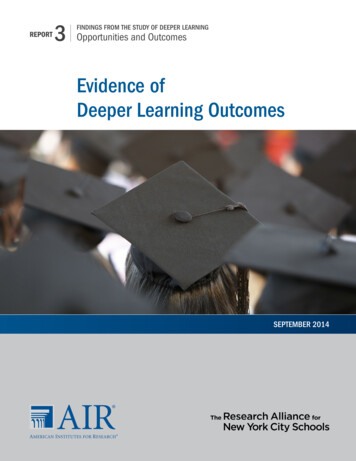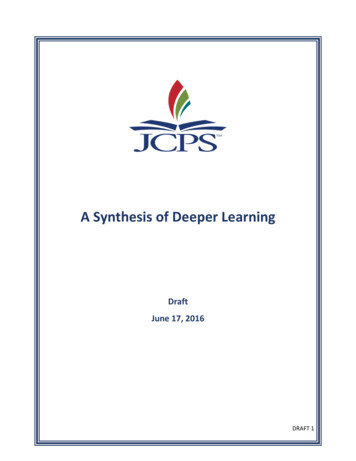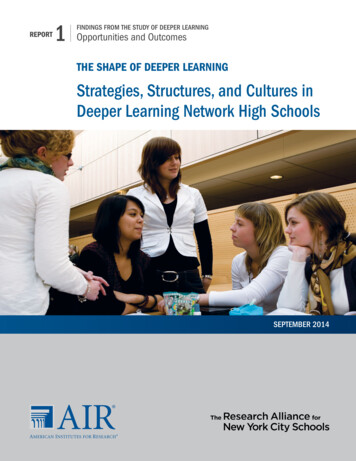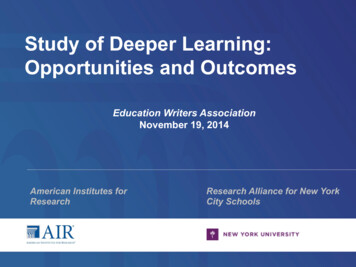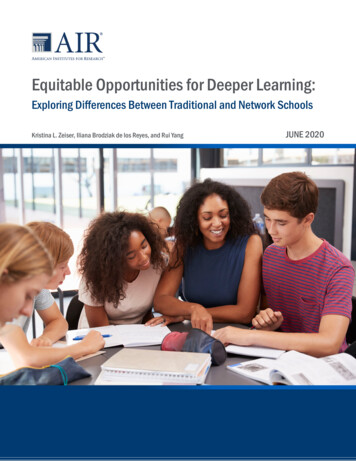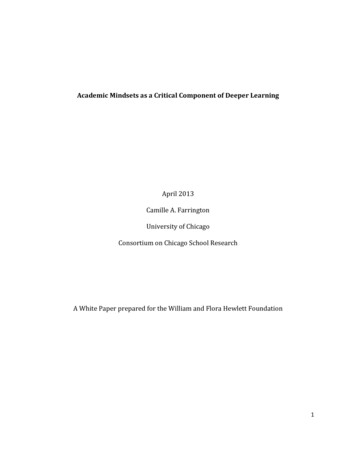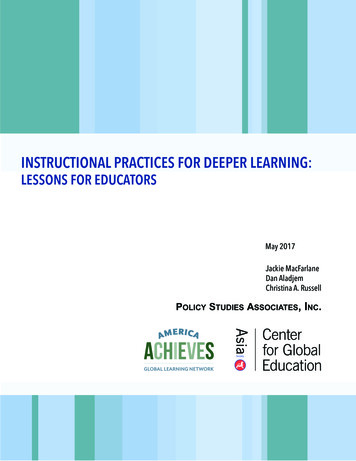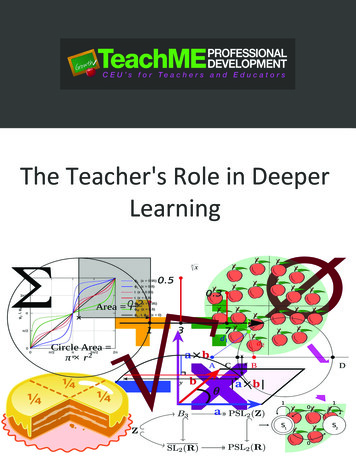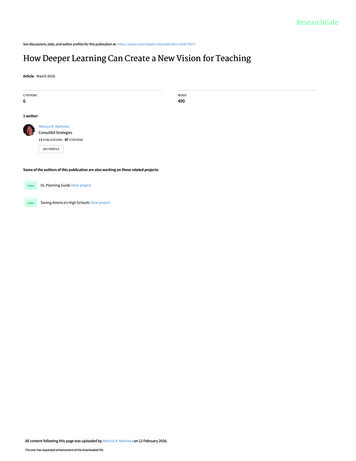
Transcription
See discussions, stats, and author profiles for this publication at: How Deeper Learning Can Create a New Vision for TeachingArticle · March 2016CITATIONSREADS64901 author:Monica R. MartinezConsultEd Strategies13 PUBLICATIONS 87 CITATIONSSEE PROFILESome of the authors of this publication are also working on these related projects:DL Planning Guide View projectSaving America’s High Schools View projectAll content following this page was uploaded by Monica R. Martinez on 12 February 2016.The user has requested enhancement of the downloaded file.
How DeeperLearningCan Create aNew Visionfor TeachingMONICA R. MARTINEZ, PHDDENNIS R. MCGRATH, PHDELIZABETH FOSTER
How Deeper Learning CanCreate a New Vision for TeachingMonica R. Martinez, PhDDennis R. McGrath, PhDElizabeth FosterThe National Commission on Teaching & America’s Future (NCTAF) was founded in 1994as a bipartisan effort to engage education policymakers and practitioners to address the entrenched national challengeof recruiting, developing, and retaining great teachers in order to ensure that all students have accessto quality teaching in schools organized for success.ConsultEd Strategists is an education consulting group for mission-driven organizations and philanthropists.We help foundations, direct service non-profits, and education agencies develop strategies to scale impact,realize organizational effectiveness, and accelerate learning.Copyright 2016 National Commission on Teaching and America’s Future 1525 Wilson Boulevard Suite 705 Arlington, VA 22209www.nctaf.orgThe National Commission on Teaching & America’s Future ConsultEd Strategists2How Deeper Learning Can Create a New Vision for Teaching
INTRODUCTIONIlived in an urban or suburban district as measured by thePISA-based tests for core content knowledge and problem solving skills; graduation rates, college enrollmentrates to selective institutions, and higher levels of collaborative skills, academic engagement and motivation(Zeiser, Taylor, Rickles, Garetand Segeritz, 2014).1magine the opportunities that today’s students willexperience as they embark on their future lives andcareers: unprecedented access to information, myriad new ways to express their creativity, effortless globalconnectivity, and academic choices and careers we can’tyet envision. And while we knowthat too many schools are stillpreparing students the same waythey did a hundred years ago,there are a growing number ofschools that are moving towarda new vision for teaching andlearning. This paper highlightsexamples of teachers, principals,and schools that have embraceda forward-thinking, student-centered approach to learning outcomes called deeper learning(and are members of the DeeperLearning Network) in order to provide students with theopportunities to develop the skills and competencies theywill need to succeed in the future.For fuller details about theteachers and schools in thispaper, read Deeper Learning:How Eight Innovative PublicSchools are TransformingEducation in the 21st Century(2014) by Drs. Martinezand McGrath.The examples in this report,from schools across the country,provide a vision for how studentlearning and learning environments are shifting; and also describe a new vision for teaching,teachers’ roles, and the conditions that need to be in place toenable deeper student learning.Many studies over the years haveprovided insight into the impact of great teachers on studentachievement and learning, especially for poor students andstudents of color (Autor, D.H., Levy, F, and Murnane, R.J.2003; Gordon, R, Kane, T.J, and Staiger, D.O. 2006; Hanushek, Eric A. 2011; Chetty, Raj, Friedman, John N., andRockoff, Jonah E. 2013). This paper instead focuses on thisshift in teachers’ work and supports because of the criticalrole teaching plays in student learning.Settings that facilitate deeper learning student outcomesamplify the impact of what teachers do by organizingthe learning environment around a set of thoughtfulcompetencies. And it works. Recently a rigorous quantitative study conducted by The American Institutes forResearch (AIR) found that attending Deeper LearningNetwork schools benefited students, regardless of theirbackground, prior level of achievement, or whether theyHow Deeper Learning Can Create a New Vision for Teaching1. The AIR study paired schools from the Hewlett Foundation DeeperLearning Network with a comparison group of schools serving similarstudents. All 20 high schools selected for the study were part of any often Deeper Learning Networks and had a mature and at least moderately well-implemented approach to promoting deeper learning.3The National Commission on Teaching & America’s Future ConsultEd Strategists
Deeper learningcompetencies result instudents’ ability to useand apply what theyhave learned.What Is Deeper Learning?Deeper learning is the term that refers to the competencies, knowledge, and skills that students must developto succeed in the 21st century, and therefore what theyshould know and be able to do when they graduate fromour public education system. According to the HewlettFoundation definition (William and Flora Hewlett Foundation, 2013; Chow, 2010) students should be able to:1.2.3.4.5.6.do not know, recognize when and how they are confused, identify the obstacles or barriers to their success,and then determine and deploy strategies to addressthese challenges. In developing an academic mindset,students are able to see themselves as academically successful and therefore trust in their own competenceand feel a strong sense of efficacy. As a result, studentsengage in positive and productive academic behaviorsand persevere when they face difficulties.Master core academic contentThink critically and solve complex problemsWork collaborativelyCommunicate effectivelyLearn how to learnDevelop an academic mindsetDeeper learning competencies address three domains:cognitive, interpersonal, and intrapersonal (Pellegrino,Hilton, Herman, et al., 2012).Taken together, the deeper learning competencies result in students’ ability to use and apply what they havelearned. This ability, known as knowledge transfer, iswidely recognized as critical to succeeding at novel tasksor new contexts (Pellegrino, Hilton, Herman, et.al.,2012). Knowledge transfer ability is important for utilizing skills in non-school environments, communicatingeffectively, and applying content in new situations, suchas future classrooms or jobs. In addition, students develop an academic mindset as well as metacognitive abilitiesand intrapersonal skills—they learn how to learn—anddevelop the ability to become lifelong learners. C ognitive: Students develop a strong academic foundation in subjects like reading, writing, math, and science. Most importantly, they understand disciplinaryprinciples and concepts. As students master content,they are more able to transfer knowledge to othersituations or tasks. Students will learn how to thinkcritically. That is, they will have the ability to synthesize and analyze information; frame questions; andrecognize patterns, trends, and relationships so theycan identify and solve problems as well as assess orevaluate the effectiveness of the proposed solution(s).Deeper learning competencies are what will help studentssucceed in a dynamic and uncertain world that places apremium on people who are flexible, creative, and innovative, and values those who communicate well andwork effectively in teams. The nature of work is changing, with less demand for routine cognitive and manualtasks and more value placed on analytic, interpersonaland creative abilities (Autor, Levy and Murnane, 2003).Organizational structures are changing as well, withmore emphasis on collaborative work and transferrableskills. A recent report by workforce economists emphasized the increasing need for individuals who can work I nterpersonal: Students learn how to work collaboratively to complete tasks, produce shared work, and understand and solve complex problems. They also learnhow to effectively communicate complex concepts toothers through a variety of modes of expression in alogical, useful, meaningful, and purposeful way. Forstudents to do this, they must learn how to clearly organize their data, findings, and thoughts. I ntrapersonal: Students learn how to monitor and direct their own learning, recognize what they know orThe National Commission on Teaching & America’s Future ConsultEd Strategists4How Deeper Learning Can Create a New Vision for Teaching
Strategies that facilitatedeeper learning for studentswill help prepare studentsto deal with the changesand fulfill the demandfor higher-level skills andprovide them with an abilityto learn in the globallyconnected economy.across networks of people, with greater efficiency and atan accelerated pace (Carnevale and Rose, 2015:12). Strategies that facilitate deeper learning for students will helpprepare students to deal with the changes and fulfill thedemand for higher-level skills and provide them with anability to learn in the globally connected economy.Teaching for Deeper LearningDeeper Learning: How Eight Innovative Public Schools areTransforming Education in the 21st Century (2014) by Drs.Martinez and McGrath identifies six strategies and pedagogical practices common across the schools committedto deeper learning outcomes for students. Their analysisfound that in order to prepare students for success in the21st century, teachers must: struction is helping students develop an understandingof learning as a complex and ongoing process that entailsseeking feedback, revising work and regularly reflectingon what one has produced, as well as on the choices anddecisions made throughout the learning process. “Revision toward mastery” is therefore a main feature of theculture and the language used by teachers committed todeeper learning (Lenz, 2015). Teachers provide feedback,as well as opportunities for students to receive feedbackfrom peers, reinforcing the idea that learning does notend with their first effort. Improving their work throughrounds of feedback, revision and reflection encouragesstudents to better understand the amount of effort required to produce high quality work.Empower students as learnersContextualize knowledge so it is coherentConnect learning to real world experiencesExtend learning beyond the schoolInspire students by customizing learning experiences Purposefully incorporate technology to enhance(not automate) learningDeeper learning leaves behind the “anemic texts, chalkand talk lectures, and fill-in-the-blanks workbooks of anearlier age” and moves teaching and learning toward anenvironment rich with opportunities “to understand anduse complex materials, communicate incisively, plan andorganize their own work, solve mathematical and scientificproblems, create ideas and products, and use new technologies in all of these pursuits (What Matters Most, 1996:5).”For example, in the English class at Science LeadershipAcademy (SLA) in Philadelphia, Pennsylvania, LarissaPahomov has her 10th grade English students use Wikispaces to create a poetry portfolio and to comment onand edit one another’s writing. Peer feedback guides students as they go through multiple revisions of their poems, while each writer’s response helps her partner learnto offer more useful criticism. By practicing a continual cycle of feedback, revision and reflection, sometimesdeemed “the learning loop” by teachers, students internalize a coherent model of learning that they can applythroughout their school experience and in their lives andcareers. Teachers provide multiple opportunities andstrategies for students to reflect on their work in orderEmpowering students as learnersTeachers who focus on deeper learning see their firstresponsibility as empowering students as learners. Forthis reason, they use pedagogical approaches that helpstudents become self-directed and responsible learnersrather than passive rule followers. The centerpiece of in-How Deeper Learning Can Create a New Vision for Teaching5The National Commission on Teaching & America’s Future ConsultEd Strategists
to better understand the connection between effort andoutcomes. This can take place as a class or small groupdiscussion, as part of an advisory (a small check-in andsupport group), or through a student’s journal or blog.Student-led conferences, where students take an activerole in reviewing their work and discussing their successes and challenges with both their teacher and parents,deepen the reflective process. Perhaps the most powerfulstrategy teachers employ to help students own their ownwork is the use of an end of year portfolio project wherestudents document, present, and reflect on their bestwork to demonstrate that they are prepared to progressthe next grade level or to graduate.ideas, relationships, issues, and skills across subjects. Students collect and analyze data in science and math classes; design and build generators in technology educationclass; develop research and writing skills in English; andwrite a land-use proposal in social studies. In addition,teachers often work together across multiple subjects todesign integrated learning experiences to connect theirotherwise separate subject-specific content.Connect learning toreal issues and settingsTeachers who focus on developing deeper learning competencies connect learning to real issues and settings inorder to make it more meaningful for students. Teachersensure that there are frequent opportunities for studentsto experience workplace conditions and expectations andaddress real world challenges and problem solving by interacting with professionals andexperts in relevant fields, takingon a professional role when doing a project, or by connectinghistorical events to current issues. For example, students atSLA learn by interacting withprofessionals and experts at theFranklin Institute, the premierscience education institution inthe Philadelphia area. Studentscan take mini-courses taught bymuseum or research staff ranging from medicine and immunology, to engineering and astronomy, to computer programming and product design.Contextualize knowledge so it is coherentTeachers who work to achieve deeper learning studentoutcomes also contextualize knowledge so it is coherentas a way to help students acquirecontent knowledge. Teachersuse guiding questions, commonthemes, and big ideas to providea context for every assignment,classroom activity, and project.Teachers at the SLA, for example, use common themes foreach grade level (such as Changein Self and Systems in the 11thgrade) and then use conceptualquestions (such as “What is therole of the individual in creatingand sustaining change?”) to helpstudents explore the themes andkey concepts in ways that facilitate the application of thisknowledge to other situations or problems. At King Middle School in Portland, Maine, teachers use two guidingquestions to link together a six-week unit for 8th gradestudents on sustainability: How do we capture and usenature’s energy?” and “How can you change your energyconsumption to improve the world?” The two questionsare echoed in all of their classes in order to connect keyAs one Casco Bay HighSchool senior said, “Before,I was a minimalist in school.I did just enough to get mypassing grade and quit. Hereit makes you want to do yourbest the first time, and if itisn’t enough, the revisionsystem helps you improve.”The National Commission on Teaching & America’s Future ConsultEd StrategistsExtend learning beyond the schoolIn addition to connecting to the “real” world, deeperlearning-focused teachers find ways to extend learning beyond the school and construct powerful student learningexperiences in a range of settings. As a result of long-term6How Deeper Learning Can Create a New Vision for Teaching
Teaching Strategies that support deeper learning outcomes for studentsstrongly align with the description of effective teaching and learningprovided in NCTAF’s What Matters Most report (1996):We know that students learn best when new ideas are connected towhat they already know and have experienced; when they are activelyengaged in applying and testing their knowledge using real-worldproblems; when their learning is organized around clear, high goalswith lots of practice in reaching them; and when they can use theirown interests and strengths as springboards for learning (1996:6).formal and informal relationships with local businesses,institutions, and community groups, the classroom wallsdrop away and the entire community becomes an annexof the school in which students have access to rich content, outside experts, additional resources, an authenticplace and context for learning, and work based experiences. At Avalon School in Minneapolis, Minnesota, forexample, students build a Mobile Community Garden aspart of their art class and focus on the use of public art.At SLA, students interview citizens who just voted duringa national election as part of a unit on suffrage and votingrights in their 11th grade government class, and juniorsat Casco Bay High School, in Casco Bay, Maine, learninterviewing and documentary filmmaking skills fromexperts at an area graduate program that teaches writing,photography, and documentary storytelling. Teachersalso extend learning beyond the school through independent projects and internships ranging from the National Park Services, an education think tank, major urbannewspapers, and high tech companies.in establishing strong relationships with students for the purpose of finding what will ignite their interest to pursue theirown learning. As Gary Allen, a physicist from General Electric who volunteers at MC2 STEM High School in Cleveland, Ohio said, “Each kid has to have their fuse lit for thatrocket to take off. You can get them out on the launchingpad, but if you don’t light that fuse, they’re not going to go.”Teachers use independent projects to both customizelearning and provide inspiration for all of their students.For instance, Kevin Ward, a teacher at Avalon Schooldrew from a powerful resource—an alumnus—to develop a personalized senior project that helped a student staymotivated and succeed academically. Calling on the student’s keen interest in military history, he introduced himto the father of an Avalon graduate who designed geological survey maps and worked with the student to createa series of maps of the Battle of Gettysburg. The teacherdescribed the student’s project as the best work he hadever done. For the student, making maps made him feelas if all the historical information he had read was comingto life and for this reason, he not only maintained his motivation throughout his senior year but also excelled anddecided to major in history when he was admitted to andenrolled at Northwestern University.Inspire students bycustomizing learning experiencesTeachers who focus on deeper learning inspire students bycustomizing learning experiences. Teachers are intentionalHow Deeper Learning Can Create a New Vision for Teaching7The National Commission on Teaching & America’s Future ConsultEd Strategists
Deeper Learning andNew Roles for TeachersUse technology in service of learningTeachers who focus on developing deeper learning competencies use technology in service of learning. Teachers purposefully incorporate technology to enhance, rather thanautomate learning; regularly employ technology tools tosupport student learning and to engage students in theirown education; and shift their role away from being thesole gatekeeper to knowledge. For example, Joshua Block,a SLA 11th grade humanities teacher, uses technology todeepen student learning by helping students select andevaluate relevant information from a variety of sourceswhile doing a project on the Spanish explorer, HernánCortés and his conquest of the Aztec Empire in Mexico.Students download material
Deeper learning competencies result in students’ ability to use and apply what they have learned. Ho eepe earnin a reat e isio o eaching 5 Th ationa ommissio eachin merica’ utur onsultE trategists struction is helping students d
